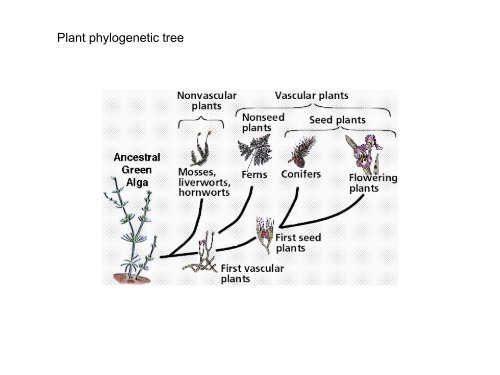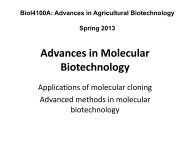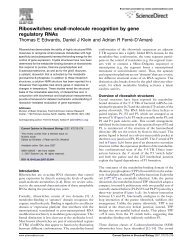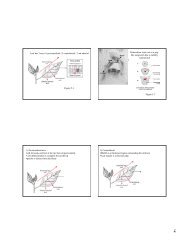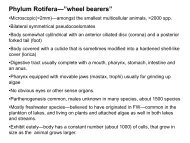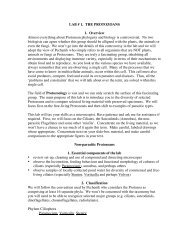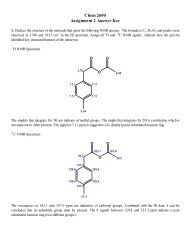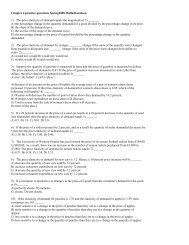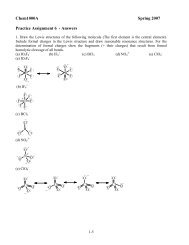Lecture 10-12Aquatic Macrophytes.pdf
Lecture 10-12Aquatic Macrophytes.pdf
Lecture 10-12Aquatic Macrophytes.pdf
Create successful ePaper yourself
Turn your PDF publications into a flip-book with our unique Google optimized e-Paper software.
Plant phylogenetic tree
The life cycle of<br />
a moss
sporophyte<br />
Sphagnum, a<br />
common<br />
wetland moss<br />
protoneme<br />
Spongy rhizoid<br />
tissue<br />
http://images.google.ca/imgres?imgurl=http://kentsimmons.uwinnipeg.ca/2152/l8fig4.jpg&imgrefurl=http://kentsimmons.uwinnip<br />
eg.ca/2152/lb8pg1.htm&h=664&w=600&sz=146&hl=en&start=2&tbnid=Jh_EsdcGnUOr6M:&tbnh=138&tbnw=125&prev=/imag<br />
es%3Fq%3DSphagnum%2Blife%2Bcycle%26svnum%3D<strong>10</strong>%26hl%3Den%26lr%3D%26sa%3DN
antheridium<br />
Antheridia clusters on the<br />
leaf tips of gametophyte<br />
archegonium<br />
Parasitic<br />
sporophyte
Fontilalis antipyretica<br />
Habitat: Water moss is found attached to rocks or logs in swift flowing water, or floating loose or<br />
attached to substrate in still water. It is common in shaded sites and prefers slightly acidic water.<br />
It requires water below pH 8.4 where dissolved carbon dioxide is available.
Most ferns are homosporous—only one kind of spore and gametophyte<br />
bears both sexes at different times<br />
Fig. 29.23
Salvinia spp: a floating aquatic fern: aggressive weeds in shallow standing waters or slow<br />
moving streams<br />
Most species polyploid and sporangia are sterile<br />
Reproduction: Salvinia molesta effectively reproduces through vegetative means. Stems fragment spontaneously<br />
as plants mature. New branches develop from apical and lateral buds. Each node harbors up to five serial lateral<br />
buds (Lemon and Posluszny 1997), adding to the high potential for growth and dormancy. Salvinia molesta will<br />
withstand periods of stress, both low temperature and dewatering, through latent buds.<br />
http://images.google.ca/imgres?imgurl=http://www.botgard.ucla.edu/html/botanytextbooks/lifeforms/images/aquaticplants/Salvinia1<br />
.jpg&imgrefurl=http://www.botgard.ucla.edu/html/botanytextbooks/lifeforms/aquaticplants/a0042tx.html&h=239&w=360&sz=24&hl=en<br />
&start=4&tbnid=Jm4d6m082X6MxM:&tbnh=80&tbnw=121&prev=/images%3Fq%3Daquatic%2Bfern%26svnum%3D<strong>10</strong>%26hl%3Den<br />
%26lr%3D%26sa%3DG
Azolla, an aquatic fern used in rice culture<br />
Is this plant homo- or<br />
heterosporous?
Phylum Pterophyta—sporophytes are vascular<br />
plants with megaphylls—ferns, horsetails, etc.<br />
Phylum Pterophyta<br />
The sphenophytes<br />
Equisetum—the horsetail<br />
•Upright jointed stems<br />
growing from a rhizome<br />
•Reproductive and<br />
vegetative stems separate<br />
Left—reproductive stems<br />
bearing strobilae<br />
Right—vegetative stems
Strobila of Equisetum with sporophylls<br />
bearing sporangia
The life cycle<br />
of Equisetum<br />
A<br />
homosporous<br />
cycle
Isoetes, the quillwort
http://www.cartage.org.lb/en/themes/sciences/BotanicalSciences/ClassificationPlants/Cryptogamia/Bryophyta<br />
/NonvascularPlants/NonvascularPlants.htm<br />
Heterospory<br />
Some ferns<br />
Quillwort<br />
Seed plants<br />
Advantages and disadvantages?<br />
Trade-offs?<br />
Homospory<br />
Most ferns<br />
Horsetails
Life-cycle stages of a flowering plant
The anther is a<br />
microsporangium, and<br />
the pollen grain is a<br />
microspore that<br />
germinates to form the<br />
male gametophyte (2<br />
cells)<br />
The megaspore is<br />
inside the ovule, and<br />
becomes an 8-celled<br />
gametophyte<br />
Fig. 30.13a
he<br />
evelopment of<br />
ngiosperm<br />
ametophytes<br />
Fig. 38.4
Although plants evolved from algal ancestors, the shift from water to air as a<br />
medium has resulted in major adaptative changes in structure and function<br />
Algae<br />
•essentially weightless and lack supporting tissue<br />
•no water or nutrient transport,<br />
•Take up nutrients through the body surface from the surrounding water<br />
•Use only holdfast cells for anchorage<br />
•Most cells can photosynthesize and they have no need for stomates or an<br />
impermeable cuticle<br />
•Gametes swim through water<br />
Terrestrial plants have gradually evolved<br />
•roots for anchorage, water and nutrient uptake<br />
•vascular tissue for water and nutrient transport, and tensile strength<br />
•Leaves with concentrated photosynthetic tissue, a waxy cuticle and stomates to<br />
regulate gas intake and water loss<br />
•Mechanisms to protect gametes from drying,<br />
•Pollination mechanisms to bring gametes together
With the exception of brypohytes which have always been heavily<br />
dependent on water, aquatic plants are mostly flowering plants that have<br />
evolved from terrestrial plants and retain many of their features<br />
Key terrestrial plant adaptations that aquatic plants retain:<br />
•most have roots or rhizomes that anchor the plant and take up nutrients<br />
•most have true leaves, supplied by vascular tissue (veins) and have vascular tissue<br />
in their roots & stems<br />
•most reproduce sexually through flowers that produce pollen and seeds
Aquatic flowering plants, although retaining fundamental features that reflect<br />
their terrestrial history, have evolved many adaptations for life in water.<br />
They don’t however revert back to their ancestral algal body plan.<br />
Root adaptations<br />
•Reduction in roots, since water uptake is not necessary, some lack roots or rhizomes<br />
•Tolerance of hypoxia—pumping O 2 to rhizomes and roots (aerenchyma) and tolerating<br />
elevated ethanol or ethylene<br />
Stem adaptatons<br />
•Lacunate tissue—spongy air-filled tissue in roots and stems<br />
•Reduction of xylem tissue—less need for support or water transport, combined with<br />
increased flexibility, substituting tensile strength for rigidity<br />
Leaf adaptations<br />
•Stomata greatly reduced or absent, cuticle very much reduced<br />
•Epidermis well supplied with chlorophyll<br />
•Thin or finely dissected leaves, to provide high surface/mass<br />
Reproductive adaptations<br />
•Flower reduction--pollination usually by water or wind, and rarely insects<br />
•Fruit modification--spongy tissue (floating) for dispersal by water<br />
•Increased reliance on vegetative propagation—fragmentation (winter buds) or<br />
suckering<br />
Overall aquatic plants remain imperfectly adapted to life in water
Common Cattail<br />
Typha latifolia<br />
Cattail family (Typhaceae)<br />
Spike bearing staminate flowers<br />
Each staminate flower bears grains of pollen; its<br />
petals and sepals are reduced to bristles. After the<br />
pollen is released, the staminate spike quickly<br />
withers away.<br />
Spike or catkin carrying pistillate<br />
flowers<br />
fertile pistillate flower has a stipe at least 1 mm. long,<br />
a single achene, and a single style with a flattened<br />
stigma. The pistillate spike persists into the fall.<br />
The blooming period occurs during early to midsummer.<br />
The root system produces thick starchy<br />
rhizomes and fibrous roots. Colonies often grow and<br />
expand vegetatively when new shoots are produced<br />
from the starchy rhizome.
Typha latifolia
http://www.tva.gov/river/landandshore/stabilization/plants/images/scirpus_americanus.jpg<br />
Bulrush—scirpus americanus<br />
Stem green, hollow, spongy, leaves few and small<br />
Well developed rhizomes, flowers small brown<br />
http://cricket.biol.sc.edu/herb/SS/Scirpus_americanus1.jpg
Scirpus microcarpus: panicled bulrush
agittaria latifolia, broad-leafed arrowhead<br />
Well-rooted in mud<br />
along shores of lakes<br />
or ponds<br />
http://www.uwgb.edu/BIODIVERSITY/herbarium/wetland_plants<br />
Flowers quite showy for an<br />
aquatic plant<br />
Incomplete<br />
i.e. pistillate or staminate
The white water lily Nymphaea<br />
Leaves floating only<br />
Well-rooted—thick air-filled rhizome<br />
http://images.google.ca/imgres?imgurl=http://www.ontariowildflower.com/images/bulrushhardstem.jpg&imgrefurl=http://ww<br />
w.ontariowildflower.com/lakes.htm&h=483&w=370&sz=11&hl=en&start=5&tbnid=fPRsJ194C3ZH3M:&tbnh=129&tbnw=99<br />
&prev=/images%3Fq%3Dbulrush%2Bflower%26svnum%3D<strong>10</strong>%26hl%3Den%26lr%3D%26sa%3DG
Nuphar variegata: bull-head pond lily<br />
Leaves floating only<br />
Well-rooted—thick air-filled rhizome<br />
http://www.uwgb.edu/BIODIVERSITY/herbarium/wetland_plants
The smartweed Polygonum<br />
Well rooted, floating leaves ovate,<br />
submerged leaves thinner
Common duckweed: Lemma minor<br />
Non rooted, floating rhizomatous leaves<br />
Lemma trisulca<br />
http://images.google.ca/imgres?imgurl=http://www.mobot.org/jwcross/duckweed/graphics/frog_in_duckweed.gif&imgrefurl=http://<br />
www.mobot.org/jwcross/duckweed/duckweedcharms.htm&h=291&w=432&sz=122&hl=en&start=1&tbnid=SyVvY42awRVryM:&tbnh=85&tbnw=126&prev=/images%3Fq%3DD<br />
uckweed%26svnum%3D<strong>10</strong>%26hl%3Den%26lr%3D%26sa%3DG
Floating leaved Pondweed, Potamogeton natans<br />
•Floating leaves ovate,<br />
• submerged leaves<br />
grass-like<br />
•Well rooted
Water milfoil, Myriophyllum exalbescens<br />
Finely<br />
dissected<br />
leaves
Potamogeton filiformis<br />
Thin fine filiform leaves, very flexible plant, well adapted for current and wave action
Potamogeton praelongus<br />
Large leaves, well rooted plant<br />
http://images.google.ca/imgres?imgurl=http://www.uwgb.edu/BIODIVERSITY/herbarium/wetland_plants/potpra_FlowersAndFruit01gf<br />
400.jpg&imgrefurl=http://www.uwgb.edu/BIODIVERSITY/herbarium/wetland_plants/potpra01.htm&h=400&w=224&sz=17&hl=en&star<br />
t=15&tbnid=61554dy6xY2IiM:&tbnh=124&tbnw=69&prev=/images%3Fq%3Dpotamogeton%2Bflower%26ndsp%3D20%26svnum%3<br />
D<strong>10</strong>%26hl%3Den%26lr%3D%26sa%3DN
Vallisneria americana<br />
http://www.uwgb.edu/BIODIVERSITY/herbarium/wetland_plants/valame_aspect01_web400gf.jpg
Vallisneria americana: a dioecious species, sexes on separate plants<br />
Flowers open at the water’s surface—wind pollinated Staminate plant<br />
Pistillate plant<br />
Also capable of asexual reproduction through vegetative “suckering”<br />
Leaves highly flexible, well adapted for high wave action
Utricularia vulgaris: common bladderwort<br />
http://www.uwgb.edu/BIODIVERSITY/herbarium/wetland_plants
Potamogeton richardsoni<br />
http://www.uwgb.edu/BIODIVERSITY/herbarium/wetland_plants
Potamogeton amplifolius, big-leafed pondweed<br />
Large leaves, well rooted plant<br />
http://www.uwgb.edu/BIODIVERSITY/herbarium/wetland_plants
Elodea canadensis<br />
Roots very reduced, stems thin fragment easily<br />
Flowers very small, on long stems that reach the<br />
surface<br />
Wind pollinated<br />
http://www.uwgb.edu/BIODIVERSITY/herbarium/wetland_plants
Ceratophyllum demersum: coonstail<br />
Finely dissected leaves<br />
Small spikes on leaves<br />
No roots or underground rhizome<br />
No flowering— reproduces by<br />
asexual fragmentation<br />
http://www.uwgb.edu/BIODIVERSITY/herbarium/wetland_plants


